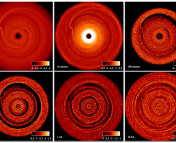Title: 13C17O suggests gravitational instability in the HL Tau disc
Authors: Alice S. Booth and John D. Ilee
First Author’s Institution: School of Physics and Astronomy, University of Leeds, Leeds, UK
Status: Published in Monthly Notices of the Royal Astronomical Society [open access on arXiv]
Protoplanetary Disk Masses
The total gas mass of a protoplanetary disk sets a limit on the material available for forming planetary systems. Although fundamentally important for understanding the planet formation process, measuring robust disk masses remains challenging. Most studies rely on observations of CO gas, which is the brightest and easiest gas tracer to detect in disks, and then extrapolate to a total gas mass by assuming a constant CO/H2 abundance ratio. However, if this CO line emission is optically thick, it only allows us to probe emission from the disk surfaces, which results in underestimated disk masses. To alleviate this, astronomers instead use line emission from rarer CO isotopologues, such as 13C16O and 12C18O, which differ only in their isotopic composition, to estimate gas masses. Due to their relative intrinsic rarity, these isotopologues are optically thin and trace gas deeper down into the mid-plane of disks. This allows for a more complete accounting of total gas mass, not just that from the disk surface layers. In today’s astrobite, we take a look at new observations of the rarest stable CO isotopologue 13C17O in the nearby protoplanetary disk HL Tau. These observations reveal a significantly more massive disk than previously estimated and imply that large regions of HL Tau may be gravitationally unstable.
Observing 13C17O Gas in HL Tau
Today’s authors detected line emission from 13C17O gas using ALMA observations of the protoplanetary disk around HL Tau, which is at distance of 460 light years away from Earth. HL Tau has long been known to be a young (~1 Myr), embedded disk-hosting star. In fact, it was the first circumstellar disk observed with ALMA’s long baselines, which revealed an ordered series of concentric rings and gaps in the disk’s dust distribution, as shown in Figure 1a. The presence of these prominent substructural features has lead to numerous theories, including the formation and growth of planets within the disk.
However, today’s study focuses instead on the gas surrounding HL Tau and represents only the second detection of 13C17O in a protoplanetary disk. The distribution and velocity structure of the 13C17O gas are shown in Figure 1b and c, respectively. 13C17O is detected out to approximately 140 AU from the central star, with a velocity pattern consistent with that of other gas tracers and the expected rotation patterns of protoplanetary disks. As shown in Figure 1d, there is a deficit of emission in both the integrated intensity map and radial emission profile at approximately 50 AU, but the authors believe that this is due to obscuration from high continuum opacities from dust, rather than a true physical gas feature.

In order to convert the observed 13C17O emission into a total gas mass, the authors model the radial structure of HL Tau in Figure 2. Since the innermost regions of the 13C17O emission are affected by continuum absorption, the authors choose to focus on reproducing the level of emission between 90 and 110 AU from the central star. As this radial location is beyond the expected mid-plane CO snowline, the observed emission will be tracing CO gas from the molecular layer down to the CO snow surface. After extrapolating their derived CO gas masses to a total H2 gas mass, they find a total gas mass of 1/5 of that of our Sun. This new mass estimate is significantly higher than previously thought and is at least a factor of 10 times higher than all previous estimates.

Gravitational Instability
To assess the gravitational stability of the HL Tau disk with its newly revised gas mass, the authors compute the Toomre Q parameter at all disk radii, as shown in Figure 3a. The value of the Q parameter compares the relative contributions from the thermal pressure of the disk versus that of the gravitational force. Regions with a Q value less than 1.7 will be susceptible to gravitational instabilities, which may lead to non-axisymmetric disk substructures and fragmentation.

As the derived mass of HL Tau is now higher, the gravitational force is similarly boosted. As a result, these new observations suggest that HL Tau is gravitationally unstable between 50 and 110 AU, as indicated in Figure 3b. While magnetic fields can provide additional support against gravitational forces, the authors find that even if HL Tau possesses a strong magnetic field, the Toomre Q values are altered by no more than 5%.
Implications for Planet Formation
Reliable gas mass estimates are critical for understanding the gravitational stability of a disk, which is directly related to observed disk substructures and overall planet-forming potential. In the case of HL Tau, several studies have suggested that a “double gap” dust feature seen at 65 to 74 AU is due to the presence of a giant planet with a mass between ∼0.2 and 0.6 of that of Jupiter. But in light of the higher gas surface density revealed by these new observations, a larger planet mass is required to match the observed dust structures. Moreover, recent observations of HCO+ J=3–2 gas have detected a spiral arm-like feature, which now can be explained by large regions of gravitational instability within the HL Tau disk.
While only detected in two protoplanetary disks so far, 13C17O gas has been shown to be a reliable tracer of total gas mass and will likely be a valuable tool for understanding the planet-forming potential and observed disk structures of many other disks in the near future.




